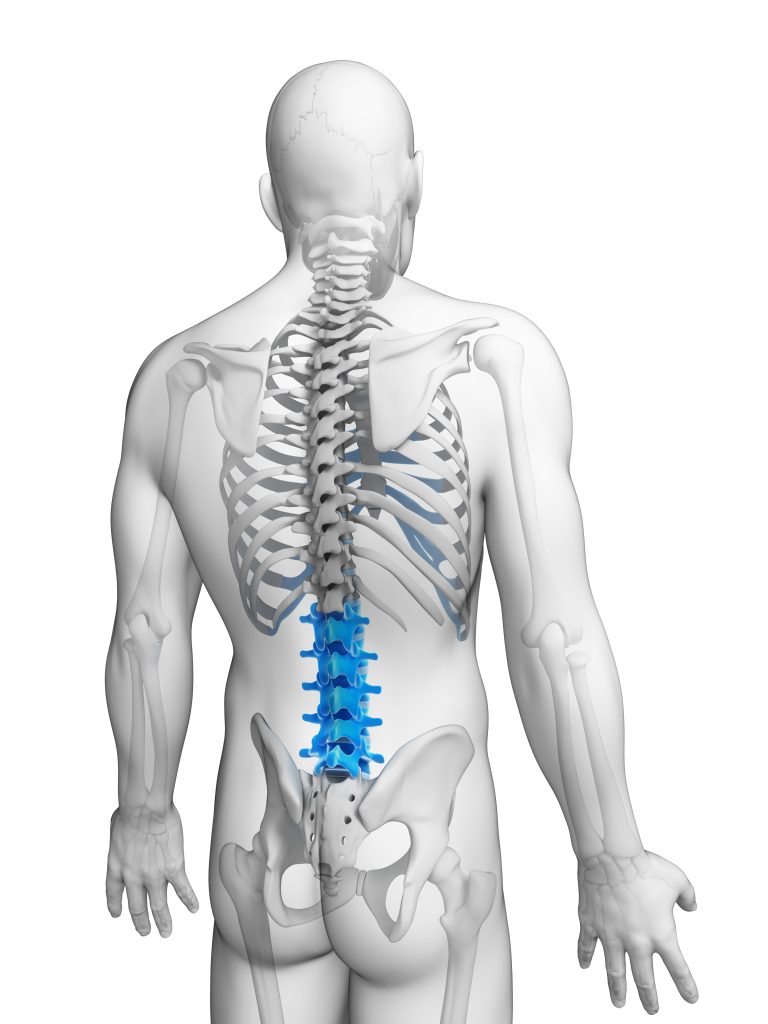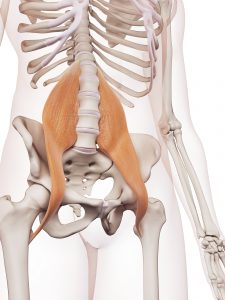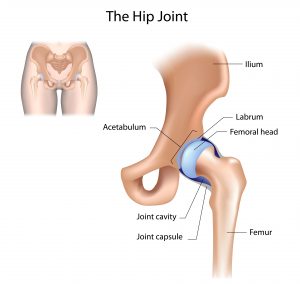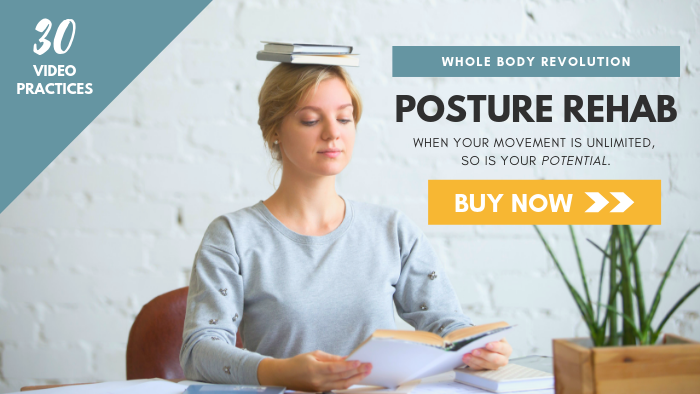Recently I was working with a client who complained of back tightness and pain. This is a pretty common problem among people who spend a lot of time in front of a computer.
Even if you have a standing desk, holding your body in one position for hours on end takes a toll.
(Side note: standing desks are not a substitute for movement. They might be an improvement over sitting all day, but that doesn’t make it healthy to work in front of a computer.)
The lumbar area is especially prone to back tightness and pain for a number of reasons. It’s the segment of your spine that has the least bony support while also bearing the most weight.

In the image above, you can see that your middle back has ribs to help support it, like the spokes of a bicycle wheel.
But your lumbar spine floats in a sea of soft tissue. Its function is to support your torso and head.
Which makes it prone to compression from weight bearing.
How Lumbar Compression Hurts Your Back
In approximately, well, 100% of my clients (give or take one or two people out of hundreds), I’ve found compression through the lower back area.
Some people have so little space between the bottom of their rib cage and the top of their pelvis that I can’t even fit a finger between the last rib and the hip bone!
This not only creates a lot of back tightness and pain. Over time, prolonged compression in this area can result in scary spinal conditions like degenerative disc disease, bulging or herniated discs, and sciatic nerve pain.
(Just a note to acknowledge that yes, many bulging discs are asymptomatic and are not necessarily an indication of pain. But I’ve also seen some pretty startling MRIs where discs are clearly impinging on the spinal cord and ain’t nobody going to be comfortable with that crap going on in their body.)
And from a purely aesthetic point of view, reduced space between your ribs and pelvis kind of makes your waistline disappear.
It’s not uncommon for my clients to notice that they look taller and leaner after we work in this area of their body. I’ve also had people tell me that the jeans they just walked in wearing an hour prior now fit more loosely and comfortably around their waist.
Magic!
(Not really. But sometimes it does seem that way.)
I show you how to get lasting relief from lumbar compression in my Posture Rehab program. But if you’re not ready to make the commitment to a full-body posture overhaul quite yet, here are four stretches that work when your back is tight and sore:
Stretch Your Psoas for Back Pain Relief
Your psoas might just be the most important muscle you’ve never heard of when it comes to addressing your back tightness and pain.
You have two of them, one on either side of your spine. They live deep in your abdomen, traveling behind all your internal organs to cross over the front of your pelvis and attach inside your upper thigh.

There seems to be some debate as to whether people need to stretch or strengthen their psoas. So, let’s just say that you need to restore proper function.
I have put my hands on a lot of bodies at this point in my career, and I can say with certainty that the majority of people have abdominal tissue that feels like a rock.
(Which is why I take some issue with the whole “core strength will fix everything” approach, but that’s a conversation for another day.)
The thing about really tight muscles is that they’re also really weak. Just like you can’t pick up a coffee mug with a closed fist, your muscles first have to relax before they can contract, i.e. get strong.
My approach to stretching the psoas:
I find that it’s most useful to employ movement to help your psoas relax. The psoas muscle is implicated in trauma responses in the body.
What that means is:
If you’ve ever had a major (or even a minor) car accident, invasive surgery, or even a bad fall as a kid, your psoas might be kind of stuck and tight. It has a hard time letting go of those experiences.
Static stretching doesn’t usually make a dent in this kind of muscle armoring. Movement does because it engages your nervous system.
Remember:
Muscles don’t get tight because they’re physically too short. They get tight because your nervous system (i.e. your brain) tells them to contract.
It’s a software problem, not a hardware one.
Which is why my Posture Rehab system focuses on restoring mobility and not on rigid alignment, like most posture programs do.
For best results, use your brain to get your body to let go. Here’s a good psoas stretch that uses elongation paired with gentle movement to ease your psoas into a relaxed state:
Release Your Tight Hips to Help with Back Tightness and Pain
Nearly everyone that I work with who complains of lower back tightness and pain also has tight hips. The two go hand in hand.
Why?
Well, your hip joint is where your femur — thigh bone — joins your pelvis. It’s a huge ball and socket joint, allowing for a wide range of motion (in theory).

Most people, though, only ever move their legs front to back, which means that muscles along the sides of the joint are often tight and/or weak, while muscles in the front (including the psoas, above) get really tight.
Over time, I find that the tight muscles around your hip joint effectively “fuse” the femur to the pelvis. I don’t mean that the bones actually grow together, but they might as well have done so.
The hip joint doesn’t move. To compensate for hip tension, I watch people use their lower back muscles to hike the pelvis up and swing the leg forward.
That means your back is doing the work that hip muscles should be doing — not good.
Over time and thousands upon thousands of steps, this takes a huge toll on the health of your lower back. So, my first order of business for anyone with lower back pain and tightness is to restore hip mobility.
There are lots of great hip stretches out there (and I’ve got a ton more in my Posture Rehab program if these don’t do it for you), but here are two that will work wonders if your hips are tight.
Don’t Forget to Stretch Your Mid Back
Just because your lower back is more susceptible to tightness and pain doesn’t mean your middle back gets let off easily. Your mid back is prone to that dreadful computer hunch from hours and hours spent pouring over spreadsheets and Powerpoint presentations.
This is especially true if you work at a laptop because, frankly, that screen is too low for your eyes.
And that causes your head to tip forward, which pulls your neck down too, until you’re hunched over like a caveman.
Anyway, the good news is that restoring good, upright alignment through your middle back is pretty easy.
Of course…
A lot of people get this one wrong.
They try to stretch the part of their back that hurts (understandably). Middle back pain is a little bit tricky.
While there might be tight muscles along your spine, it’s more likely that tension in your chest and across the front of your shoulders is pulling you into the rounded hunch.
So you want to make sure and stretch these muscles first. Then, if you still have middle back pain and tightness, you can work on that area directly. (More on that inside Posture Rehab.)
Here’s a great stretch to open up the front of your body and help you stand taller again:
Do The (Spinal) Twist for A Healthy Back
There’s nothing like a good spinal twist to release tight muscles.
One thing that I look for when assessing my clients for healthy movement is:
Does their spine twist when they walk?
We call this contralateral movement (you don’t have to memorize that, or even know how to pronounce it).
Basically, when you walk, your body twists in the middle, like wringing out a rag. As your left leg extends out behind you, your right shoulder swings forward and vice versa.
It’s so common to see people who are struggling with all kinds of back pain lacking this twisting movement through the spine.
Yet another issue with a lot of core strength exercises is that they often lock down your back and abs and don’t allow the movement of your hips and legs to travel upward through your spine.
No bueno.
So, after getting people’s hips freed up, I like to work on restoring contralateral movement. Stretches that twist your torso are great for this.
So much of what we do in our daily lives is uniplanar.
Meaning:
We don’t spend a lot of time twisting our bodies or moving sideways. Sitting, standing, working at a computer and driving are all forward-focused activities. Adding intentional twists is great for maintaining healthy spinal mobility throughout your life.
Twists are so powerful that I’ve included several to open up your back, hips, ribs, neck, and shoulders inside my Posture Rehab program. It’s absolutely the best practice to restore lost mobility to any part of your body.
This video offers a great and easy twisting stretch (and a few other healthy back practices to boot):
For more great videos to keep your body moving well, check out the Posture Rehab video course.
Life is too short to live it in pain.


Leave a Reply